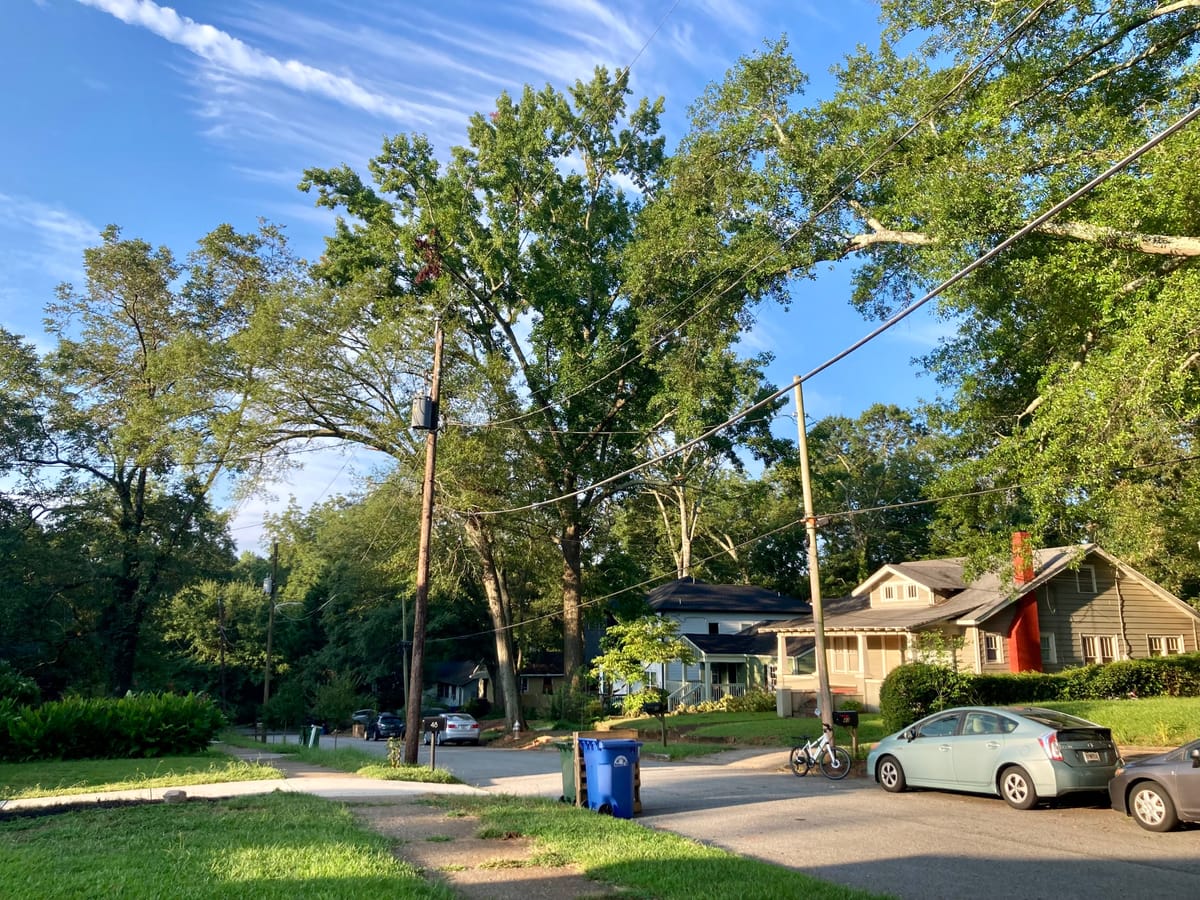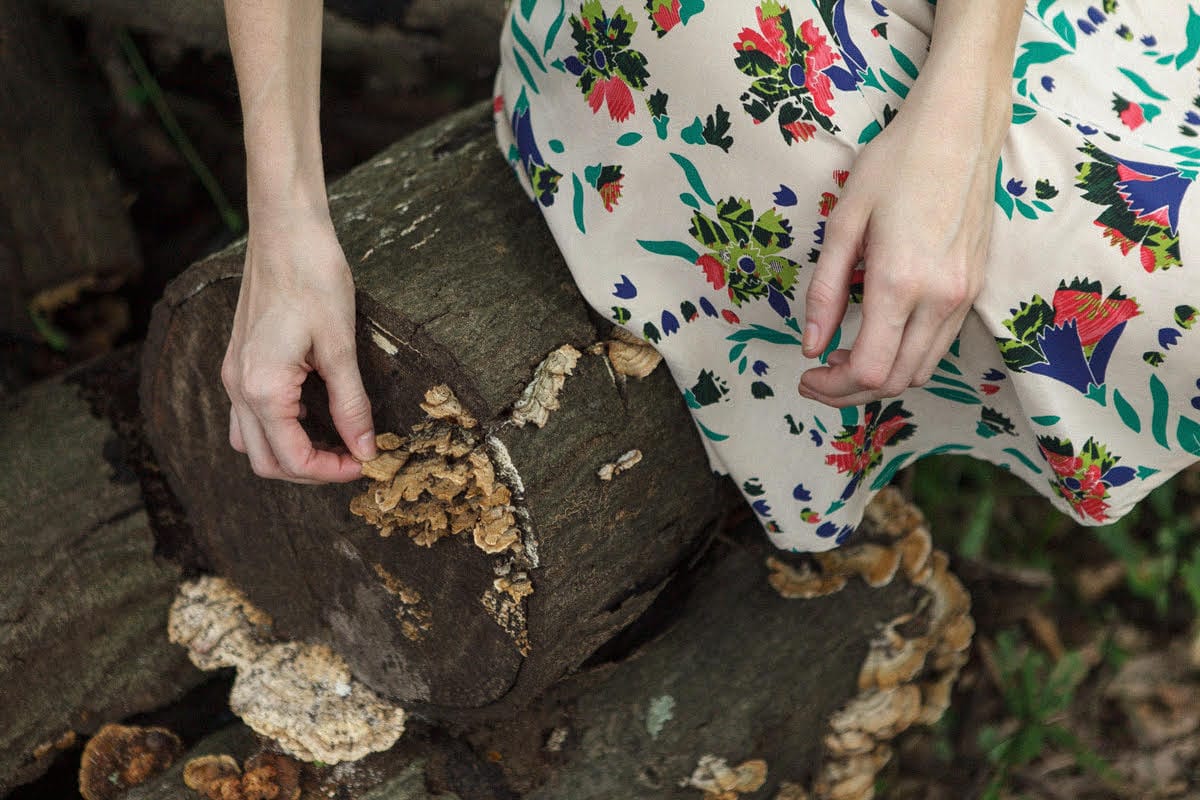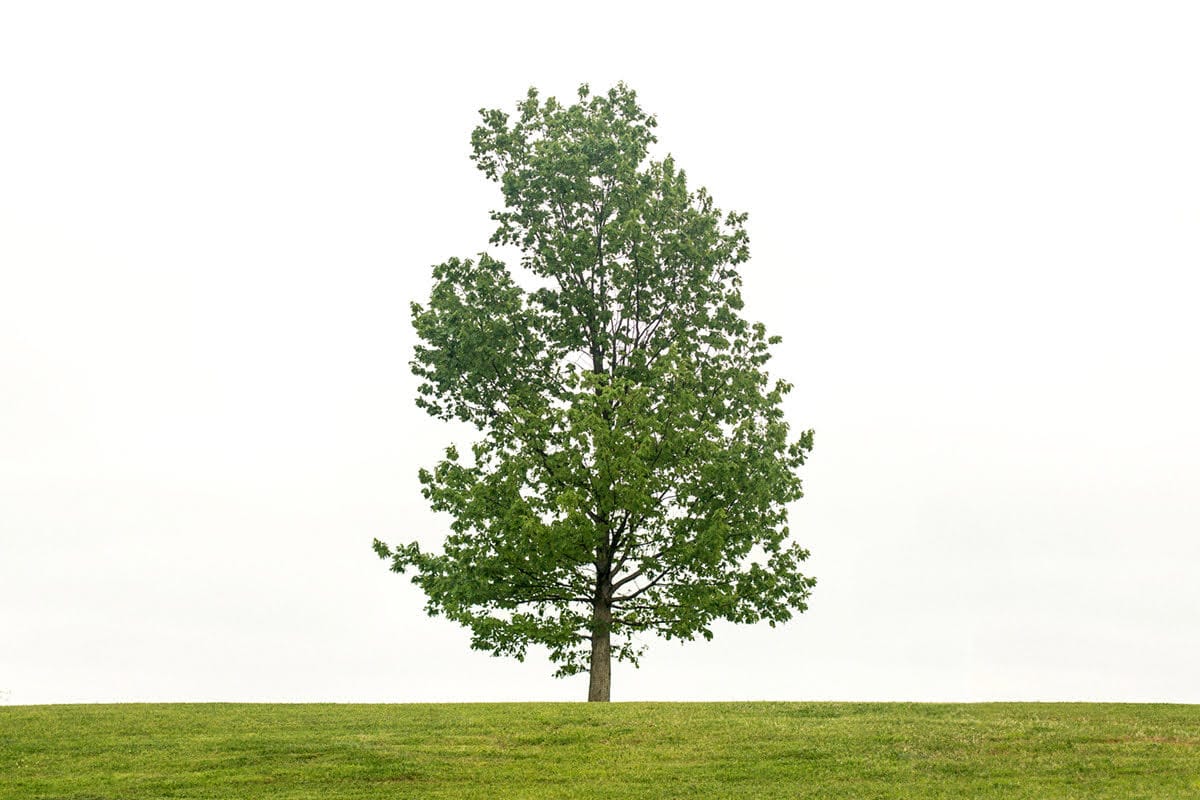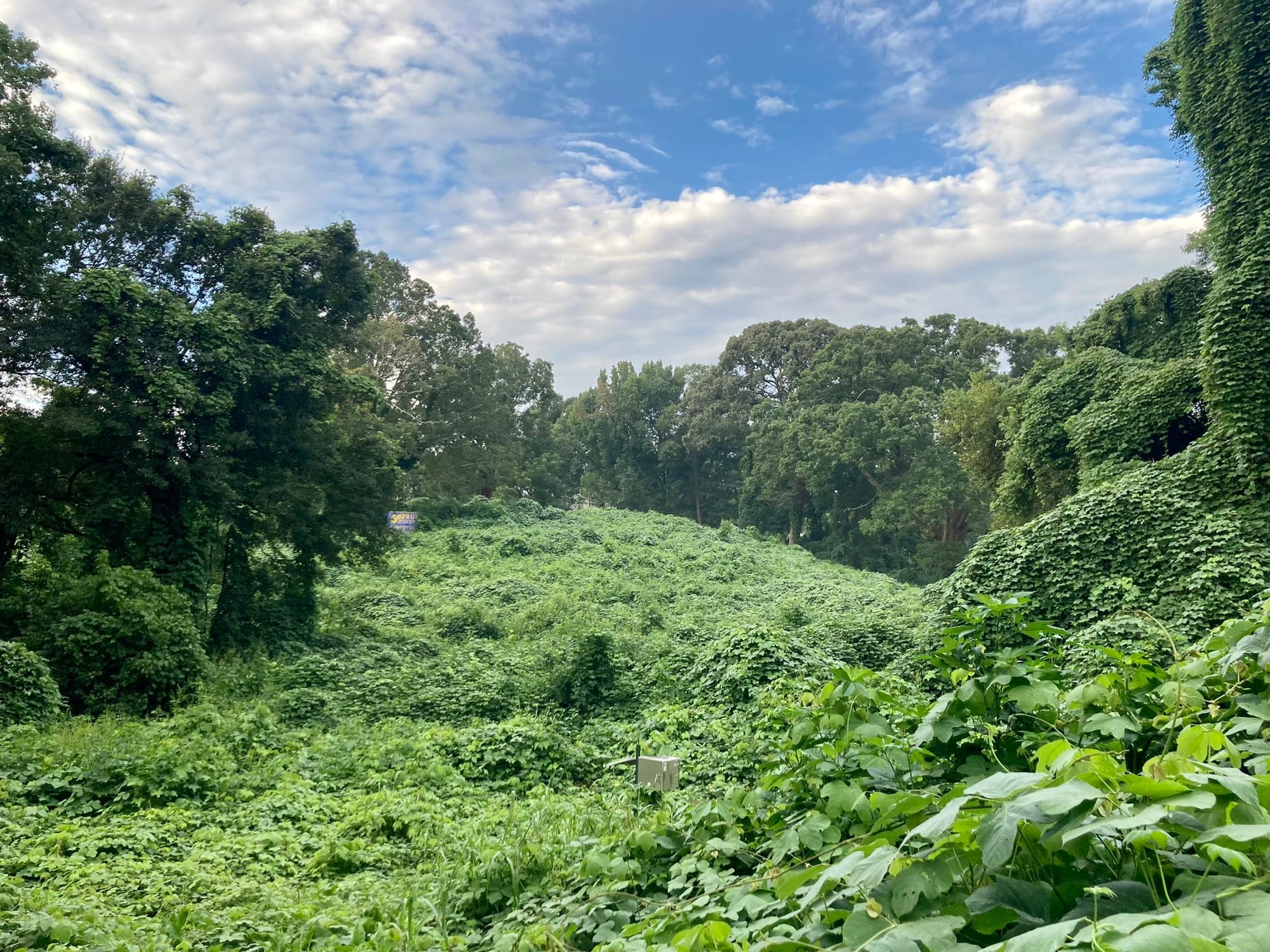
For the nine years my family lived in Kirkwood, I had a nemesis. She stood outside our house watching everything we did. She saw our lights come on in the morning and go off at night; she saw my husband and I carry in the groceries, take out the trash, and bring the baby home from the hospital. It snowed once or twice; it rained a lot; it was often very, very hot. And all the while she stood there, silent, swaying, growing ever more powerful.
My nemesis was a tree, an absolutely gargantuan American sweetgum. She was chartreuse in spring, solid green all summer, torch orange in the fall, and every winter dropped a maddening volume of seed pods, hundreds upon hundreds of spiky brown ping-pong balls that bonked passersby on the head and got tangled in dogs’ fur, and induced cartoonish sidewalk wipeouts, though that’s not why I hated her.
I wouldn’t even say I hated her. She was old enough to be my grandmother—the yard, the street, the sky were hers long before they were mine. I was in awe of her. But also, she stood very many feet high and not many feet from my house and on sunny mornings she cast a shadow right over my infant daughter’s bedroom. I knew that, despite her hale and hearty appearance, at any moment she could fall right over and absolutely destroy my life.
Of course, I also knew that at any moment I could call an arborist, pay a fine, and absolutely destroy her life, too.
Trees need us, we need trees, and we both have the power to kill one another. This tension has always existed between human beings and the other living things on this planet. But nowhere is that easier to forget than in the middle of a sprawling American metropolis, even in Atlanta, our so-called “city in a forest.” But maybe also nowhere is it more important to remember.
Atlanta has the largest urban tree canopy of any major city in the United States: 46.5% of its total 85,760 acres is covered by some sort of tree growth, according to a 2018 Urban Tree Canopy study contracted by the City of Atlanta and conducted by researchers at Georgia Tech. The benefits of trees to a city are so profound as to seem banal: They clean the air, they cool the air, they cool otherwise-sizzling streets and sidewalks, they divert and absorb stormwater runoff. Their presence is a psychological boon wherever they grow, and in Atlanta, where we’ve made them central to our self-conception, they’re existentially crucial as well.
All of this is currently under threat. Our canopy is shrinking, down from 47.9% in a similar study done in 2008, down by who knows how much since the city became a city. A primary culprit is our local custom of unchecked real estate development. Increasingly, the City of Atlanta itself seems culpable as well; for too long, officials have wrung their hands over how to manage the city’s trees while dragging their feet on straightforward solutions. And meanwhile, many of the signature trees of our intown neighborhoods were planted nearly a century ago, meaning they’re nearing the end of their natural lifespans at a time when, already hampered by suboptimal urban growing conditions, they now face increasingly extreme weather induced by climate change.
In other words, they are falling down. Younger, stouter trees are falling down, too. They fall on roads, they fall on yards, they fall on houses, they fall on cars. Sometimes they hurt people. Sometimes they kill people. Sometimes they don’t fall, they just loom, causing acute psychological distress that drives people to eliminate the tree before the tree eliminates them.
At this point, I should say that, despite my use of “we” and “our” here, Atlanta isn’t technically mine anymore. This spring, after 20-ish years in the city, my family moved to Chattanooga, where my husband and I grew up. But this gave me some distance, physical and psychological, that has been useful in trying to make sense of Atlanta’s and its trees. And from my 120-mile remove, it seems to me that Atlanta is overdue for a reckoning.
For a long time now, Atlanta’s relationship with its trees has been deeply unbalanced. You’re panicked about losing trees, but you don’t know what to do with the trees you have. You either take them for granted or obsess over them, deify them or vilify them, sacrifice them too casually or anthropomorphize them to a ridiculous degree. Forget being unable to see the forest for the trees—you can’t even see the trees themselves.
But to avoid a total crisis (environmental and existential), you need to get clear-eyed. What does it mean to have so many people living among so many trees? How can you best wield the power you have over them? And how can you make peace with all the power they have over you?

To begin with, Atlanta needs to stop thinking of itself as “a city in a forest.” People brandish this nickname like it’s some lofty UNESCO designation when, in truth, it’s no more official than “Hotlanta.” (“Hotlanta,” bless its heart, is at least accurate.) Atlanta doesn’t have a terribly long municipal history, so it tends to behave as if it has no history at all, and the self-identification as “city in a forest” both stems from and reinforces this amnesia. The phrase is fundamentally misleading, calling to mind something pure and bucolic—a colony of gnomes carving high-rises from fallen logs?—when the reality is anything but, and increasingly so.
If you live in Atlanta, you live on land that the United States government pilfered from the Muscogee (Creek) Nation nearly 200 years ago, land that white settlers and Black enslaved people razed to build a fast-growing town that became a battlefield and then a faster-growing city, one pathologically inclined to build itself up and tear itself down as often as needed to maintain its sense of forward progress. Atlanta has trees, of course. A lot of trees, in fact! And some of those trees do indeed comprise forests. But they are very much in the city, not the other way around.
The apparent origin of the phrase adds another level of irony. An Atlanta Journal editorial from February 1967 is the earliest instance I can find of anyone calling Atlanta “a city in a forest,” and even then it was already in the past tense. “Trees are a nice thing for a city to have,” editor Jack Spalding wrote. “Atlanta formerly had so many we didn’t have to bother. We were a city in a forest, shady and loaded with oxygen. Now? We’re being denuded. In summer we bake. The air isn’t as fresh. Why? We’ve been careless of our one distinction, and that is our woodland setting.”
In 1967, Spalding was writing in support of the city’s first tree protection ordinance, a draft of which had recently been presented to the Board of Aldermen, precursor to the City Council. Despite complaints from supporters that the ordinance didn’t go far enough, and complaints from detractors that it went so far as to be unconstitutional, the Board passed the ordinance that summer. Primarily targeting developers, it limited how many trees could be cut down along public thoroughfares, required city arborist approval to remove more than a certain number of trees on a given property, required city arborist approval of landscaping plans for most new developments, and set fines for violations. The ordinance was simultaneously groundbreaking—few American cities had implemented anything like it—and sandbagged from the start, as Atlanta had neither a city arborist on staff nor the money to hire one. The Board of Aldermen wouldn’t approve the budget to fund its own ordinance until December 1968, a year and a half later.
Six decades on, Atlanta is still denuding, lamenting, and haphazardly trying to save its trees all at once. The tree protection ordinance has been expanded and transformed over the years (notably to require permits of homeowners as well as developers), but continues to live on a weird bureaucratic see-saw, still somehow both too much and not enough.
I’m not a policy expert, I’m not an environmentalist, I’m just an erstwhile resident who has been thinking a lot about this lately. But it seems that Atlanta has a history of thwarting its most promising tree-protection efforts with incompetence and indiscretion. In 2001, the City began funneling the fines it collects from developers and homeowners for unpermitted tree removal into a Tree Trust Fund (TTF), meant to fund planting new trees around town and buying up local greenspace to protect. Since 2020, in partnership with the Conservation Fund, the City has used TTF funds to acquire nearly 400 acres of greenspace, including the 216-acre Lake Charlotte Nature Preserve in the South River Forest, one of the largest untouched forests left within city limits.
But according to an internal audit, between 2009 and 2019—a decade during which the City’s own study would show that the canopy was shrinking—the City misspent $2.5 million from the TTF on administrative costs, while also failing to collect upwards of $2 million in fines from developers and homeowners. There might have been even more money to mismanage if the City had updated its fees even once since launching the TTF in 2001. But they hadn’t, and still haven’t. Very little in Atlanta costs what it did at the turn of the millennium, including planting new trees, but it’s cheap as ever to illegally chop one down, the fine still calculated at $30 per inch of the tree’s diameter measured at breast height. According to Trees Atlanta, the city’s own 2019 assessment suggested updating the fine to $240 per inch. Five years later, a fair recompense would surely be higher.
Since at least 2018, when Atlanta’s tree canopy dropped to 46.5%, the City has had a loose goal of one day hitting 50%. In April 2023, the City Council passed a resolution to make that goal official. By when? They didn’t say. By what means? Also unclear, beyond running a study every five years to assess the effectiveness of the Tree Ordinance in meeting that goal. Will that happen? Who knows!
In December 2022, the City Council passed updates to the Tree Ordinance for the first time since 2007. When those changes went into effect in April 2023, the City positioned them as the first phase of a multi-part update. Local environmental groups—including Trees Atlanta, which partners with the City on many of its tree-planting efforts—criticized the toothless new rules. The City promised more oomph in phase 2, coming that summer. A year later, that subsequent phase has yet to materialize. How many more trees might be growing right now if not for all this squandered money, time, and trust? Is it even working, this system of fines and fees and permits? I don’t know, but the City should at least stick to the rules it made up for itself.
Of course, anything the City of Atlanta does or doesn’t do about its trees now happens in the context of its South River Forest bait-and-switch, which illuminated the pitfalls of a conservation strategy that hinges on municipal benevolence. In 2017, the City pledged to preserve 300 acres of the South River Forest in Southeast Atlanta. (This is separate from the 216 acres preserved at Lake Charlotte.) But in 2021, the City reversed course and turned at least 85 of those acres over to the Atlanta Police Foundation to be cleared for a massive police training center, defending the move in part by claiming the land wasn’t worth preserving after all.
“There’s still a forest, it’s just not a forest where this is right now,” Mayor Andre Dickens told Charles Bethea of The New Yorker in 2022. This statement was both oddly worded and untrue—the site is very much part of the South River Forest, which Atlanta’s own planning department has called one of the four “lungs of the city.” But development continues, as do protests from residents, activists, and environmental advocates. Turns out, it’s tough to be a city in a forest and an aspiring police state.

An underappreciated fact is that the big-c City of Atlanta owns only a small fraction of the little-c city of Atlanta’s trees. The vast majority of the canopy, 75.5% of it, is growing on privately-owned land, mostly single-family residential property. This means that the primary stewards of Atlanta’s most valuable natural resource aren’t elected officials, or certified arborists, or passionate environmentalists. They’re just people who own houses with yards. The City’s Arborist Division decides which trees can or cannot be legally removed and issues permits and fines accordingly, but otherwise, property owners are left to their own devices to manage 30,659 acres of Atlanta’s 40,609-acre canopy.
When my husband and I bought our house, in 2015, we didn’t think of ourselves as stewards of anything. We knew that we were responsible for the house itself and the patch of ground it stood on, but the trees seemed more ambiguous. Did we own them too? What did it even mean to “own” a tree? In time we learned that we had full custody, as it were, of three gnarly old dogwoods and my aforementioned nemesis, the massive sweetgum. The latter was growing right at the edge of our front yard, and its branches had long ago become intertwined with those of an oak that was thriving, somehow, in the strip of earth between our sidewalk and the street, but that was City property, so the oak was a City tree. The gigantic pecan tree growing in our narrow side yard, smack dab on the property line, belonged half to us and half to our neighbor.
The houses on either side of us were both owned by Black women in their eighties, matriarchs who’d raised their children there, children who were now old folks themselves. The families of both women paid guys to mow their grass, but tree care was either not on their radars or not in their budgets. Our uphill neighbor, the woman with whom we shared the pecan tree, now lived in a nursing home, leaving her house empty. Her son was more than happy for us to pay the full $1,875 it cost to remove the pecan tree, which an arborist, the City of Atlanta, and my own personal nightmares agreed was a hazard. But there were still a half dozen big trees looming in that backyard, and half a dozen more in our downhill neighbor’s yard. Their trunks wore thick stoles of ivy; they often dropped limbs so rotten they exploded into dust upon impact with the ground. Those branches fell with such force I hated to think about a whole tree coming down.
But of course I did, all the time.
The trees knitted us together with our neighbors in strange ways. If one of our trees needed to be pruned or cleared of vines, we were responsible for it. If one of our trees dropped a limb in our yard, we were responsible for it. If one of our trees dropped a limb or fell into our neighbor’s yard, they were responsible for it. If a tree fell in our yard, or on our car, or on our house, whether it was our tree or our neighbor’s, we were responsible for it. If a limb or a tree fell from our tree or a neighbor’s tree and was partially in our yard and partially in their yard, we were responsible for whatever part lay in our yard, and they were responsible for whatever part lay in theirs. If we had concerns about a tree in our own yard, we could call an arborist to check it out, and pay to take care of it if needed. But if we had concerns about our neighbors’ trees (and we did), our options were murkier.
On one hand, we could’ve had a conversation with our neighbors, relayed our concerns about the trees, and worked out a plan together. Or we could’ve been more formal, sending them certified letters sharing a licensed arborist’s assessment that their trees were hazardous and needed to be removed; this way, if the trees did fall, our neighbors, and not us, would be responsible for any damage to our property. We never had the conversation, and while we did get the arborist’s assessment, we never sent the letter. At first, I was too self-conscious of the optics, too aware of being young white gentrifiers pestering older Black neighbors on fixed incomes about yard care.
But even after our downhill neighbor died and her family sold the property to a contractor who promptly knocked down the house and commenced building a five-bedroom behemoth on its 1947 foundation, touching neither the half-dozen oaks nor the miles of ivy choking them out, I couldn’t make a move. Partly this was because I was about to have a baby, and then I had a baby, and while I was more worried than ever about a tree falling on our house, I was also too profoundly sleep-deprived to do anything about it. But also, for as much as I feared those trees, I did think they were wonderful. When our neighbors moved into their homes half a century earlier, back when their own babies were babies, the oaks had been lithe young things. Now they were so big their longest limbs reached across my backyard to touch one another like old friends. They were living things supporting other living things, from the hawks and the bluejays squabbling in their branches to the fat squirrels feasting on their copious acorns. The trees themselves had come to feel like neighbors—neighbors I lowkey suspected might one day kill me, but not enough that I wanted to kill them first.
Anyway, it was that damn sweetgum I really wanted gone. The arborist told us she looked healthy, especially for a big old tree hemmed in on two sides by a concrete walkway; he wouldn’t cut her down, and the City certainly wouldn’t grant us a permit. This was great news for the tree, which got to continue living, and bad news for me, who got to continue dithering over what else could be done to prevent my daughter from being crushed in her crib.
I knew trees could go rogue—a friend’s house was once knocked askew on its foundation after a backyard oak dropped a limb on her roof, days after an arborist deemed it healthy. I knew I would only stop worrying if the tree was gone, and I knew I could make it go away if I really wanted to, but did I really want to? All I had to do was hire a less-scrupulous arborist and pay the City’s fine—not cheap, but certainly not impossible.
People do this all the time, notably a woman in Virginia-Highland last summer, much to the consternation of her neighbors, who claimed the tree she illegally removed was more than 400 years old. This was a dubious claim (the oldest known local tree, a white oak in Decatur’s Deepdene Park, is thought to be about 250 years old), but the tree in question was undeniably humongous. According to a local news report, the woman had lost one child and was afraid the tree would fall and kill her other children. Pitted against those human stakes, and the ability to pay a $4,360 fine, what chance did the old tree stand?
I thought about this woman often, especially whenever a thunderstorm woke me in the middle of the night and I lay awake in bed wondering why I didn’t go yank my daughter from her room and the potential path of the falling sweetgum until the storm had passed. What kind of mother was I for letting her sleep in harm’s way? Why did this tree matter to me more than my own child? What amount wouldn’t I pay to keep her safe, to make this fear go away? And then I would tell myself what I always told myself, which is that whatever I was worried about probably wouldn’t happen, and if it did, it probably wouldn’t happen the way I thought it was going to happen. Indeed, according to the National Safety Council, the odds of being killed by a falling tree are so low as to be incalculable. Then again, so are the odds of dying in an airplane crash, but tell that to any atheist muttering the Lord’s Prayer under their breath during takeoff.

Nobody knows how many trees are growing in Atlanta and nobody knows how many trees fall in Atlanta every year. But they do fall, lots of them, and while most cause no bodily harm, they’re still a menace. A single fallen limb can cost hundreds of dollars to cut up and haul away. When a whole tree falls on a house, the wreckage and the cost are immense—doubly so if it falls during a rainstorm, adding water damage to the mix. Insurance may cushion the blow, but even the best coverage can’t offset the time cost and psychological toll of such a life disruption: evacuating family members and pets, salvaging belongings, securing alternate housing, assessing damage, managing repairs, filing claims, replacing what’s replaceable, mourning what’s not. And if you’re under-insured, or uninsured, or in any way struggle with navigating bureaucracy, the costs are exponentially higher.
Atlanta’s trees are distributed unequally across the city, as are resources for proactive maintenance and dealing with the mess when they inevitably fall. Three of the four neighborhoods with the fewest trees are lower-income and majority-Black, but all four neighborhoods with the most trees are also lower-income and majority-Black, meaning people living there enjoy all the benefits of a lush urban canopy but feel more acutely the financial burden of both maintaining it and being unable to maintain it. Certified arborists work safely and legally, but not inexpensively. It can cost several hundred dollars to prune a tree, and several thousand to remove one, even if the City grants a permit. Multiply that across a densely-wooded lot and the cost is astronomical. Cut-rate crews charge less, though they may work more haphazardly, endangering people and trees alike and incurring steep fines from the City. But if you can’t afford to remove a troublesome tree, or if your landlord is unable to or unwilling, and that tree falls, the cost of its damage may be even greater than the cost of removal would’ve been. And trees don’t just fall on homes—they crush vehicles, too, which can be a heavy blow in car-centric Atlanta, especially for people working low-wage, inflexible jobs.
Up to $200,000 annually from the Tree Trust Fund is earmarked to assist low-income residents with tree maintenance, but it’s unclear how to access this resource. In fact, the only mention I can find online is in the text of the ordinance itself. Ironically, Buckhead, the neighborhood most financially equipped to privately manage its share of Atlanta’s trees, experienced the most canopy loss between 2008 and 2018, due to its voracious, wealth-driven and wealth-multiplying development. In this resource gap, which the City seems less than motivated to fill, there is an opportunity for mutual aid funds or community support networks to emerge: grants or micro-loans or supplies or housing for people displaced by fallen trees, advice for navigating insurance claims and repairs, neighborhood work days or even pro-bono help from certified arborists to help prevent future tree damage. It’s kind of like when two trees’ branches grow together over time, or how a cluster growing together can better bend against the wind. Because when it comes to caring for people put out by its trees, much like caring for the trees themselves, the City has mostly left you on your own.

Last summer was particularly rough for Kirkwood’s canopy. One breezeless afternoon some of my neighbors watched a towering oak fall across four lanes of Hosea L. Williams Drive, somehow only scratching a mailbox. A few blocks down, a traffic light was out for weeks after another oak fell in a storm and took out multiple poles. An oak directly across the street fell too, landing uphill and narrowly missing an apartment building. Every time the wind picked up, my whole body clenched.
And then it happened. In late July, one of our downhill neighbor’s trees finally fell: a double-trunked oak in their front yard, an old pal of our sweetgum. It split one Saturday during an early-morning thunderstorm, one trunk falling across the street and the other laying itself down along the sidewalk. My family and I were out of town until the following afternoon, so we missed the moment of impact, a boom-crash so loud it woke our neighbors six houses up the street. We saw only the partially-chainsawed aftermath, chunks of trunk and mangled branches and sawdust everywhere, severed power lines coiled like snakes in the wreckage. The upturned rootball stood six feet high above a pit of raw red clay. A couple from California had bought the new-build behemoth that spring and promptly scheduled an arborist to remove many of the yard’s old trees, but the appointment had been delayed by the summer’s frequent storms. Now it was delayed again.
When the tree fell, it took with it a section of chain-link fence that its trunk had long ago grown around, a wedge of concrete from our driveway its roots had tunneled under for years, and utility lines feeding homes up and down the street. Our house’s service drop line was yanked with such force it peeled the weatherhead half off the siding, and when an electrician arrived to reconnect us, he discovered that our whole electrical system was out of code, necessitating a cascade of repairs that kept my family out of our house for a week, long after our neighbors’ power was fully restored, though many of them were displaced for at least a few days. We spent a few nights at a jungle-themed Airbnb, then my daughter and I went to my parents’ house in Tennessee while my husband stayed behind to purge our spoiled fridge and freezer, manage the electricians, run in circles with Georgia Power, and occasionally squeeze in work for his actual job. It was a mess, not a crisis—we were lucky to have the money and time and family support we needed to clean it up. But what a mess. The falling tree had barely touched our yard and still managed to briefly flip our life sideways.
For the rest of the summer, people stopped to take photos of the tree’s remains and its huge root ball, posing for photos in the hole like it was a famous hole. “Wow!” they would say. “Wow!” The tree never received much attention while it was upright, but its absence was remarkable. Once we could park in the driveway again, our car was always hot. We used to park in the shade, but now there was none. It was hotter inside the house, too. I imagined the sweetgum gobbling up all the extra sunlight and converting it directly into a bumper crop of spiky hell balls.
In October, when the arborists finally arrived to cut down the rest of our neighbors’ trees, they rolled up with multiple trucks and a crane. They worked for days, cutting small branches first, then big ones, then the trunks, working carefully as if they were disassembling machinery they meant to reassemble elsewhere. I stood with my daughter in the driveway, squinting into the sun as we watched them work, the early fall breeze occasionally anointing us with sawdust. I was so relieved to see them go. I was so sad to have them gone.
When my family moved to Chattanooga earlier this year, it wasn’t to escape the trees—though I have to admit, it’s a profound relief that our new place is safely out-of-range of all the house-crushers on our leafy street. When it storms, I still wake up thinking of the sweetgum. May it loom for another hundred years.
Trees are strange things in a city, untidy things, straddling the realms of public and private, personal and communal. I’ve been trying to resolve these tensions here, but I think it might be a fool’s errand. I keep returning to that quote from Andre Dickens in The New Yorker: “There’s still a forest, it’s just not a forest where this is right now.” As it concerned the matter at hand (the site of the police training center) his statement was, of course, false. But in its muddled phrasing, it sounds like some esoteric koan, one that perfectly encapsulates Atlanta’s deep ambivalence about its canopy—and, by extension, itself.
We are a city in a forest; we were a city in a forest. There aren’t enough trees; there are too many trees. We must protect our trees for our safety; we must sacrifice our trees for our safety. There’s still a forest, it’s just not a forest where this is right now. Maybe these tensions are the essence of living in Atlanta, or maybe they’re the essence of living, period. Maybe you’re always at the mercy of something—trees, or other people, or time itself—and something is always at the mercy of you. Maybe the best you can do is just remember that, and hope that it’s at least something beautiful.

Rachael Maddux
Rachael Maddux is a writer.
